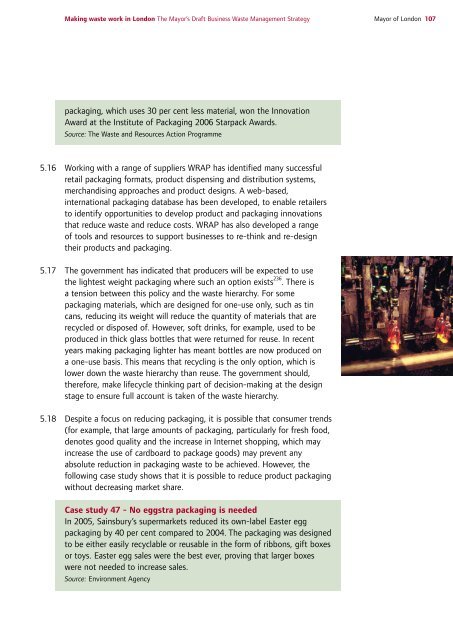Draft Business Waste Strategy PDF - london.gov.uk - Greater ...
Draft Business Waste Strategy PDF - london.gov.uk - Greater ...
Draft Business Waste Strategy PDF - london.gov.uk - Greater ...
Create successful ePaper yourself
Turn your PDF publications into a flip-book with our unique Google optimized e-Paper software.
Making waste work in London The Mayor’s <strong>Draft</strong> <strong>Business</strong> <strong>Waste</strong> Management <strong>Strategy</strong> Mayor of London 107<br />
packaging, which uses 30 per cent less material, won the Innovation<br />
Award at the Institute of Packaging 2006 Starpack Awards.<br />
Source: The <strong>Waste</strong> and Resources Action Programme<br />
5.16 Working with a range of suppliers WRAP has identified many successful<br />
retail packaging formats, product dispensing and distribution systems,<br />
merchandising approaches and product designs. A web-based,<br />
international packaging database has been developed, to enable retailers<br />
to identify opportunities to develop product and packaging innovations<br />
that reduce waste and reduce costs. WRAP has also developed a range<br />
of tools and resources to support businesses to re-think and re-design<br />
their products and packaging.<br />
5.17 The <strong>gov</strong>ernment has indicated that producers will be expected to use<br />
the lightest weight packaging where such an option exists 236 . There is<br />
a tension between this policy and the waste hierarchy. For some<br />
packaging materials, which are designed for one-use only, such as tin<br />
cans, reducing its weight will reduce the quantity of materials that are<br />
recycled or disposed of. However, soft drinks, for example, used to be<br />
produced in thick glass bottles that were returned for reuse. In recent<br />
years making packaging lighter has meant bottles are now produced on<br />
a one-use basis. This means that recycling is the only option, which is<br />
lower down the waste hierarchy than reuse. The <strong>gov</strong>ernment should,<br />
therefore, make lifecycle thinking part of decision-making at the design<br />
stage to ensure full account is taken of the waste hierarchy.<br />
5.18 Despite a focus on reducing packaging, it is possible that consumer trends<br />
(for example, that large amounts of packaging, particularly for fresh food,<br />
denotes good quality and the increase in Internet shopping, which may<br />
increase the use of cardboard to package goods) may prevent any<br />
absolute reduction in packaging waste to be achieved. However, the<br />
following case study shows that it is possible to reduce product packaging<br />
without decreasing market share.<br />
Case study 47 - No eggstra packaging is needed<br />
In 2005, Sainsbury’s supermarkets reduced its own-label Easter egg<br />
packaging by 40 per cent compared to 2004. The packaging was designed<br />
to be either easily recyclable or reusable in the form of ribbons, gift boxes<br />
or toys. Easter egg sales were the best ever, proving that larger boxes<br />
were not needed to increase sales.<br />
Source: Environment Agency
















